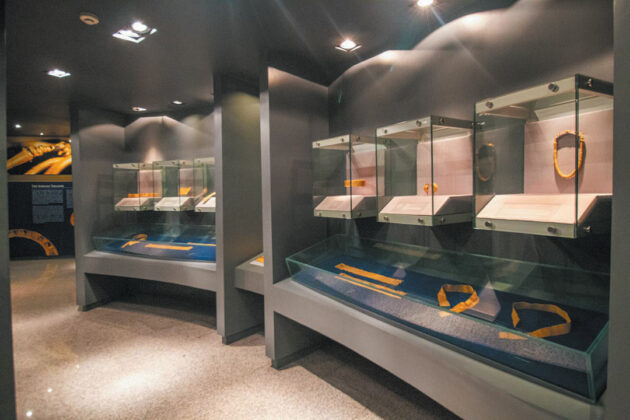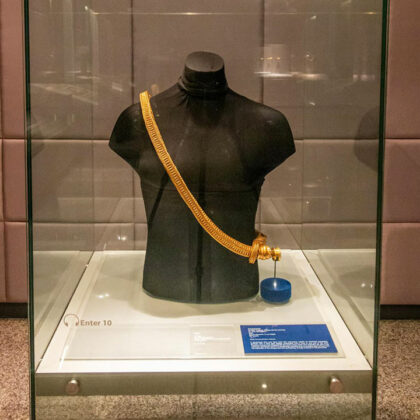Gold treasures reunited at the Ayala Museum
BELTS, necklaces, bangles, scale pans, and other golden items — 38 in all — from the Bangko Sentral ng Pilipinas’ (BSP) pre-colonial gold collection have been reunited with the Ayala Museum’s existing collection of gold. Forty-three years after being discovered in the same landfill, these objects can now be seen together again for the first time, at the exhibition “Reuniting the Surigao Treasure” which officially opened on May 16.
At the exhibit launch, guests were ushered upstairs to the museum’s 4th floor in groups. Ayala Museum senior director Ma. Elizabeth “Mariles” Gustilo prefaced the visit by emphasizing the historical significance of the artifacts, and the exhibit’s timely opening for the museum’s 50th anniversary.
“Ayala Museum was established 50 years ago by the Filipinas Foundation, now known as the Ayala Foundation, to empower Filipinos through a deeper understanding of our traditions, art, history, and culture,” said Ms. Gustilo.
“We mark this milestone expression of love of country with what is appropriately something old, something borrowed, and something blue.”
The Philippines’ two priceless gold collections were reunited thanks to curator Dr. Florina Capistrano-Baker. The 38 gold items loaned from the BSP fill in gaps in the precolonial picture painted by the 1,000 artifacts on permanent display at the Ayala Museum.
ORIGINS OF THE TREASURE
The gold objects in the exhibition were uncovered on April 27, 1981.
Edilberto “Berto” Morales, a heavy machinery operator working on an irrigation project in Sitio Magroyong, barrio San Miguel, Surigao del Sur, unexpectedly unearthed golden objects scattered along a 100-meter stretch of landfill quarried from a nearby mountaintop.
“This accidental discovery, along with others recovered by other treasure hunters who collectively swooped into Magroyong, are collectively known as the Surigao Treasure,” explained Ms. Capistrano-Baker, at a tour of the newly mounted exhibit.
Though a few gold items were hacked apart and melted down by treasure hunters, many were saved through the efforts of Dr. Jaime Laya, then BSP governor, and private collectors National Artist for Architecture Leandro Locsin and his wife Cecilia, whose collection eventually went to the Ayala Museum.
“The Surigao collections at BSP and Ayala were recovered from a single culture area associated with the ancient kingdom of Butuan. They are twins separated at birth, now reunited,” Ms. Capistrano-Baker said.
To emphasize which objects belong to which collections, the items from the Ayala collection are displayed with a white background, while those from the BSP are shown on a blue background. When items from both collections are shown together, the pieces from each are shown with the corresponding color.
ITEMS THAT GO TOGETHER
The exhibition finally gets to tell a fuller story of precolonial Butuan.
The most impressive object is a massive, four-kilogram gold chain believed to be a Hindu upavita, or sacred thread, a mainstay at the Ayala Museum. A pronged finial, or distinctive ornament, from the BSP’s collection now completes the chain at the waist.
“The finial was offered to Mrs. Locsin with the red gemstone, but she thought it looked like a bicycle bell and passed on it. But when she saw the chain, she realized they were meant to go together but couldn’t run after the finial anymore since it already went to BSP,” said Ms. Capistrano-Baker.
While now reunited, it unfortunately remains incomplete — the red gemstone has not been seen since it was offered to Mrs. Locsin.
Also paired together are intricately woven gold waistbands, seven of the belts from the BSP collection now joining multiple sashes and buckles from Ayala’s collection. They are solid proof of the power and opulence once found in ancient Butuan in northeastern Mindanao.
Other remarkable objects from BSP include a 4.5-meter long kamagi chain consisting of 12 necklaces connected end-to-end, weighing almost 1.5 kilograms, gold bangles set with semi-precious stones, and necklaces consisting of susô beads.
Ms. Capistrano-Baker pointed to a screen mounted in the exhibition, which shows a video documentary by Cheche Lazaro under Probe TV. There, she said, Mr. Laya recollects the journey of the treasure.
“When Mang Berto found the long kamagi chain, he wrapped it around his waist several times to hide it from coworkers, which ended up at the BSP. There’s also the gold bowl which he initially thought was a helmet, now part of the Ayala Museum’s collection,” she said.
Another interesting reunion is that of Ayala Museum’s gold balance scale that likely belonged to a rich merchant, and the BSP’s gold weighing scale pan. These are seen as evidence of the Butuan culture’s advanced trading with neighboring polities long before European contact.
“This extraordinary collaboration reunites in one exhibition for a limited time entwined treasures from the country’s two premiere gold collections, allowing us to lift the veil of collective amnesia and reclaim the contours of our half-forgotten precolonial past,” Ms. Capistrano-Baker said.
“Reuniting the Surigao Treasure” is now open to the public and will be on view at the Ayala Museum in Makati until 2027. — Brontë H. Lacsamana





